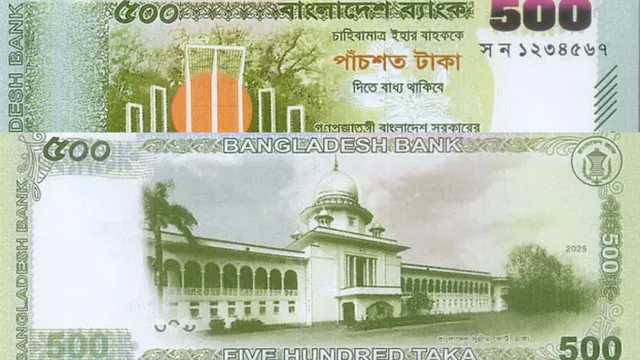- By Supratik Das
- Mon, 02 Jun 2025 08:42 AM (IST)
- Source:JND
In a historic move reflecting the country’s changing political landscape, Bangladesh has introduced new banknotes without the image of its founding father and former Prime Minister, Sheikh Mujibur Rahman. They are marked by Hindu and Buddhist temples, national monuments, and art heritage, instead, as per the Bangladesh Bank. This is the first large denomination currency redesign following the collapse of the Awami League government a year ago, after a student revolution which saw Prime Minister Sheikh Hasina leave the country in August 2024. The new banknotes, phased in release, are part of the central bank's initiative to project a "neutral and cultural" national identity.
According to Bangladesh Bank spokesperson Arif Hossain Khan, the new banknotes will feature no human portraits, diverging from decades of tradition. Instead, the designs will showcase natural landscapes, archaeological sites, and traditional architecture. “Under the new series and design, the notes will not feature any human portraits, but will instead showcase natural landscapes and traditional landmarks,” Khan told AFP. Three denominations, 1000 BDT, 50 BDT, and 20 BDT, have been issued on Sunday, June 1, and the remaining ones will be introduced step by step after Eid. The new notes will coexist with the current series of notes featuring Sheikh Mujibur Rahman's portrait.
What’s On Bangladesh’s New Notes?
The new currency notes have features that combine history with cultural variety. According to the Bangladesh Bank, the features are as follows:
• 500 BDT note: Frontal part contains the Central Shaheed Minar and a flowering Shapla (national flower) design. The reverse contains the Bangladesh Supreme Court, topped with a Bengal tiger watermark.
• 200 BDT note: The Front part of the yellow coloured note contains the iconic Aparajeyo Bangla sculpture of Dhaka University. The reverse part contains student-designed graffiti from the 2024 student revolution entitled "Graffiti-2024".
• 100 BDT note: Front of this blue coloured note features the Sixty Dome Mosque (Shat Gombuj Masjid) in Bagerhat; back depicts the Sundarbans.
• 10 BDT note: The pink coloured note shows the National Mosque Baitul Mukarram in the front, while the back has the 2024 uprising graffiti.
• 5 BDT note: Front depicts Tara Mosque, and the back again features the Graffiti-2024, with a Bengal tiger watermark.
• 2 BDT note: Light green coloured note bears the Martyrs' Intellectual Memorial in the front, and the reverse side bears the Rayerbazar Killing Field Memorial.
Each note bears the signature of the current Bangladesh Bank Governor Ahsan Habiib Mansur, except for the Tk 2 and Tk 5 notes, which carry the signature of Finance Secretary Khairuzzaman Majumdar.
Change In Currency Design Mirrors Political Changes
It is not for the first time that Bangladesh has changed its currency in light of political changes. Following its freedom in 1971, the first notes had a map of Bangladesh. With time, Over time, Sheikh Mujibur Rahman became a permanent feature on currency during the long rule of the Awami League. Under past eras of the Bangladesh Nationalist Party (BNP) rule, the focus shifted to archaeological and historic sites, a trend now revived under the interim government headed by Nobel laureate Muhammad Yunus. The Bangladesh Bank had signaled last year, soon after the removal from power of Sheikh Hasina, who is now charged with crimes against humanity in absentia for her participation in the 2024 crackdowns.
The redesigned Bangladeshi currency is an emblematic force for political change and national self-reflection. By substituting political leaders with depictions of history, culture, and fortitude, Bangladesh seems to be embarking on a different path for national identity based on diversity, memory, and beauty.

